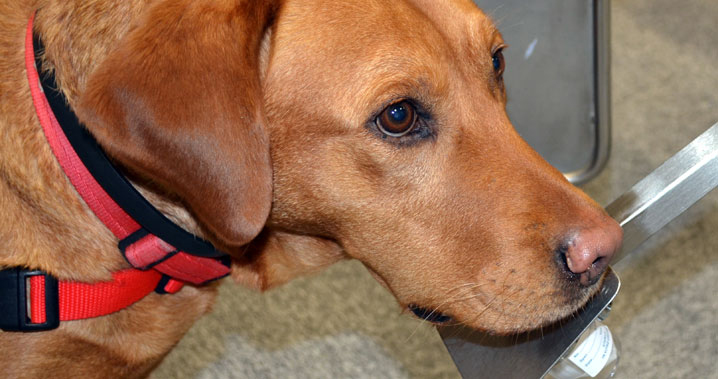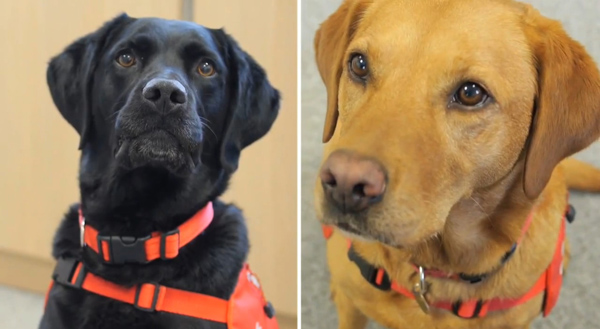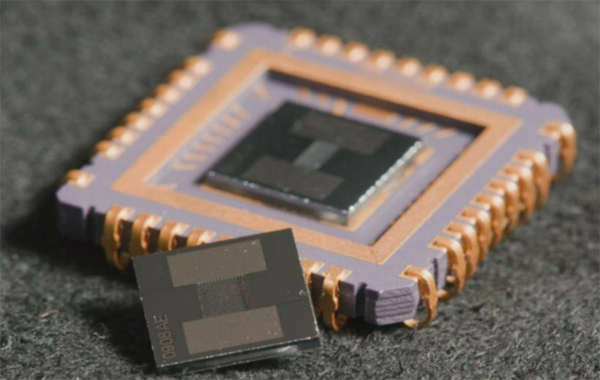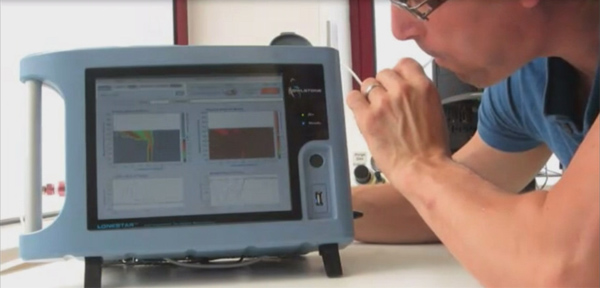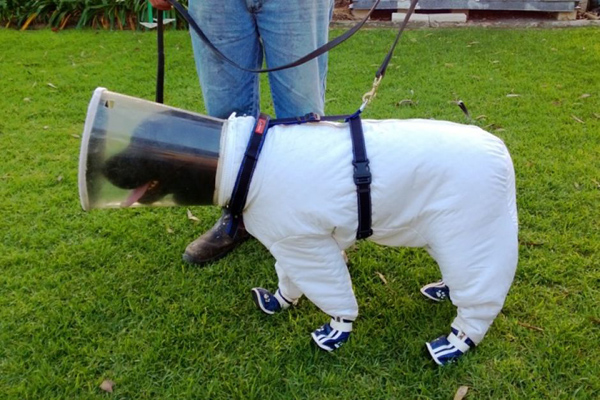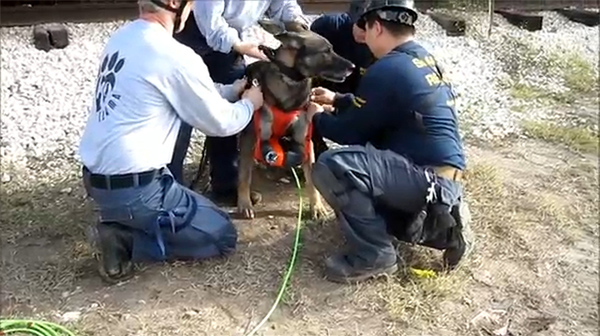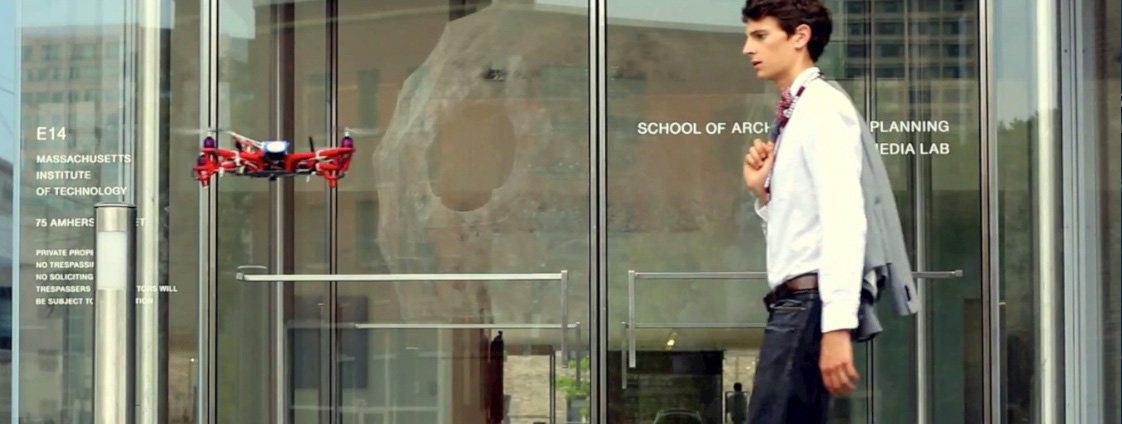A dog’s nose is a wondrous thing. That cold, wet snout that pokes between the bed sheets and wakes you up in the morning can sift through scents at an astonishing parts per trillion. Imagine taking a sip from several Olympic-sized swimming pools and tasting the presence of just a pinch of sugar and you get the idea.
Medical Detection Dogs Lucy and Daisy
It’s a super power we barely understand even as we continue to try to match it through technology. We get envious hints of what’s possible through the incredible working relationship we’ve crafted with service canines.
A search-and-rescue dog can locate a body even if it’s been weighed down and tossed into the middle of a lake. Standing at the prow of a police boat with its nose in the air, a sniffer dog can sift through the currents caressing the surface and pinpoint the corpse even as it rests under twenty feet of water.
After years of anecdotal stories about dogs detecting cancer, a 2008 study published in The Lancet confirmed the phenomenon, giving rise to trained Medical Detection Dogs which now work with hospitals around the world to offer early detection of cancers from breath, urine, and stool samples.
Dr. Claire Guest, who was part of that pioneering study and is the founder of the UK’s first team of medical detection dogs, is working to add breast cancer to the list after one of her dogs indicated that she herself had the disease.
Here she is speaking about her operation and how the dogs work:
Owlstone Nanotech is one of several companies working on an electronic version of a dog’s nose. They have developed a gas-sensing microchip that can sift through medical samples at an impressive parts per billion and, in some applications, actually match a dog’s parts per trillion capability.
Because of the way microchip technology can be shrunk down once proven, Owlstone plans to use it to produce a handheld Breathalyzer. Like a medical detection dog, the device will be able to pick up on the chemicals on our breath that can lead to an early detection of disease. Through potential partnerships with smartphone manufacturers, it might even appear as a built-in feature on your next phone.
The silicon sensor works on a principle called Field Asymmetric Ion Mobility Spectrometry (FAIMS), which means that as gaseous particles pass over it, electrical signals will repel all but the desired chemicals to the side, creating an accurate filter. The advantage of using a microchip in this way is that it can be reprogrammed, allowing signals to rapidly adjust and change which desired chemicals can pass through.
“In a lot of sensors, trying to reduce size worsens the performance, but with FAIMS the opposite is true” says Owlstone co-founder Billy Boyle. “The scale involved means that as we make the size smaller, using silicon fabrication techniques, the performance actually improves. The micron-scaled gaps allow us to generate very high electron fields, and this is the key to sensitivity and selectivity.”
Before the Breathalyzer can revolutionize medicine, however, it needs to be told what to look for. While you can give a dog a stained cloth and let it go, a microchip needs to be programmed with a digital profile. A number of research clinics across Europe are currently working on developing “scent fingerprints” for key diseases. The hope is that the wait won’t be a long one.
This demonstrates a key point, which is that you can create an electronic dog nose, but that doesn’t mean you’ll be able to use it like a dog would. Our research into a dog’s smell perception is still in its infancy, but what little we know is pretty intimidating.
Dogs can work each nostril independently, allowing them to sense the direction of a smell without turning their heads. Every breath they take is divided between an air flow for breathing and an entirely different one for their brain where a whopping 12.5% of its mass processes the incoming data compared to our measly 1%.
An initial study at the Institute of Zoology in Zurich suggests that dogs can actually exchange location data when they smell each other’s breath, not only picking up on something tasty that another dog might have eaten, but also the related scent data to work out where they got the meal too.
Several early studies suggest that dogs can measure time through smell, that by gauging how much a scent has faded, they can work out how long it’s been since the scent’s owner left.
The most dramatic example of this concerns anecdotes of dogs somehow “knowing” when their owners are about to come home. They just suddenly sit next to the door or look out a window mysteriously, only to correctly predict the arrival of their owner by minutes.
Researchers have come up with the interesting theory that it’s their owner’s smell that is the clock. When you leave for work in the morning, you leave behind your scent in the house. As the day passes, the scent gradually fades. If you come home on a fairly regular schedule, your dog can use the rate by which your scent fades to measure when you’re due back home.
This would mean that your dog has learned to associate the moment when your scent has degraded to a specific level of weakness with the moment you come home from work. Some stories have it that dogs can predict their owner’s return within a ten minute window and that’s staggering.
Working dogs provide a constant education as to how smell can be used to change our world. In Real Estate they are hired to detect damage from termites. In Napa Valley the wineries use them to sniff corks for signs of taint. Conservationists employ them to monitor the health of whales by tracking down feces in the ocean. Apiarists have adopted them to sniff bee hives for early signs of disease. In the case of the bees, the threat is such a serious one that beekeeper Josh Kennett designed a custom beekeeper’s outfit for his sniffer dog Bazz.
photo: Josh Kennett
Of course each of these is a potential use for Owlstone Nanotech’s Breathalyzer. Not that it can truly replace a well-trained sniffer dog, but rather complement the industry created around them through a low-priced handheld that can delivery such capabilities into a greater number of hands.
Beekeeper-in-training sniffer dog Jesse learns to screen for American Foulbrrood disease using empty hives
Sniffer Dogs have such an integral role in our understanding of how we can make use of scent to solve problems, that most technology inspired by them is made to better help them do their job and enhance their powers.
In 2004 FEMA Canine Search Specialist Mike Forsythe turned heads by skydiving with his rescue dog O’Cara from an astonishing height of 30,100 feet. O’Cara made the leap thanks to a canine-shaped O2 mask and a pair of protective “doggles”.
photo: Andy Anderson
Forsythe and his rescue dogs have helped pioneer a number of search technologies including a GPS dog harness that vibrates to give the dog’s directions in order to participate with coordinated searches and a remote audio system that would allow handlers like Forsythe to issue simple verbal commands to their charges even when they disappear out from sight.
Ryerson University’s N-Cart program has been collaborating with Carnegie Mellon to explore the way robots and dogs can work together in search-and-rescue operations. Dogs can’t be beat when it comes to digging and navigating through rubble, but are fairly limited in reporting back details once they’ve found someone. If only they could talk.
So in 2012 the two research groups tested a canine harness that would allow a rescue dog to carry a snake-like robot against its chest. When the dog finds a survivor it can then activate the robot with a special bark command, triggering it to detach so that handlers can remote-control the snake to get in closer with a camera for a proper inspection.
If dogs could talk you can bet they’d find our vocabulary for describing smells embarrassingly small. We’ve invented few words for scent and tend to describe most things as “smelling like” something else, such as “lemon” or “rain” or even “dog”.
If dogs could use our smartphones they’ve find we’ve made great advances in touch, sound, and vision while completely avoiding potential life-changing uses for scent. Hopefully, if we can continue to work with them and develop technologies inspired by them, we might just one day smell what we’ve all been missing.

